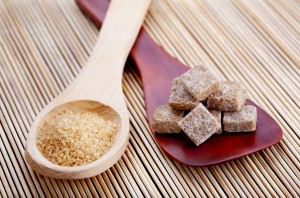Sucralose and Splenda
To clear up some of the confusion on Splenda and other products using Sucralose I have been researching the side effects of this chemical. Please read your labels very carefully and look for any hidden sugars(Click here for a list) and chemical additives. The way to “take it off and keep it off” is being aware of these products additives that can cause you to regain your weight.
A little history on Sucralose according to Medicinenet.com:(Click here to read the full article)
Sucralose is the newest non-nutritive sweetener on the market. It is most well known for its claim to be made from sugar. It is used alone or found in Splenda and is 600 times sweeter than sucrose (table sugar). When used alone, it provides essentially no calories and is not fully absorbed. In 1998, it was approved for limited use, and in 1999, it was given approval for use as a general-purpose sweetener. It is currently found in over 4,500 products, including foods that are cooked or baked. This artificial sweetener that can be used for cooking, so it has rapidly become one of the most popular and highly consumed artificial sweeteners.
The most misunderstood fact about sucralose is that it is nothing like sugar even though the marketing implies that it is. Sucralose was actually discovered while trying to create a new insecticide. It may have started out as sugar, but the final product is anything but sugar. According to the book Sweet Deception, sucralose is made when sugar is treated with trityl chloride, acetic anhydride, hydrogen chlorine, thionyl chloride, and methanol in the presence of dimethylformamide, 4-methylmorpholine, toluene, methyl isobutyl ketone, acetic acid, benzyl triethly ammonium chloride, and sodium methoxide, making it unlike anything found in nature. If you read the fine print on the Splenda web site, it states that “although sucralose has a structure like sugar and a sugar-like taste, it is not natural.
The presence of chlorine is thought to be the most dangerous component of sucralose. Chlorine is considered a carcinogen and has been used in poisonous gas, disinfectants, pesticides, and plastics. The digestion and absorption of sucralose is not clear due to a lack of long-term studies on humans. The majority of studies were done on animals for short lengths of time. The alleged symptoms associated with sucralose are gastrointestinal problems (bloating, gas, diarrhea, nausea), skin irritations (rash,hives, redness, itching, swelling), wheezing, cough, runny nose, chest pains,palpitations, anxiety, anger, moods swings, depression, and itchy eyes. The only way to be sure of the safety of sucralose is to have long-term studies on humans done.
Splenda is a product that contains the artificial sweetener sucralose, but that is not all that it contains. Sucralose does have calories, but because it is 600 times sweeter than sugar, very small amounts are needed to achieve the desired sweetness so you most likely won’t consume enough to get any calories. The other two ingredients in Splenda are dextrose and maltodextrin, which are used to increase bulk and are carbohydrates that do have calories. One cup of Splenda contains 96 calories and 32 grams of carbohydrates, which is often unnoticed due to the label claiming that it’s a no calorie sweetener. Since this is found in so many products and can be used in cooking, it can be possible to consume 1 cup or more each day. For people with diabetes, this is a significant amount of carbohydrates, and for people who are watching their weight, this can be a problem. Consuming an additional 100 calories a day can result in a weight gain of 10 lbs. per year!
A recent study found that Splenda affected the absorption of medications in rats. The rats were given sucralose at doses of 1.1-11 mg/kg. After 12-weeks, they found that the rats had half of the good bacteria in the gut. They also found that Splenda interferes with the absorption of prescription medications. Other research studies have come out to show that this is not what happens. The only way to know for sure is to perform long-term studies in humans. Unfortunately, this takes time. It can also be dangerous if this is actually happening. The limited number of studies and lack of long-term studies on sucralose means that we are going to have to learn things like this as we go.


Your welcome! We really need to teach everyone how to be a label detective
and it will help them make better choices.
Shawna Culp
Media Producer
[…] Phase 3. There is usually an introduction of new foods that is too fast, hidden sugars (sucrose, sucralose), introducing too much dairy too quickly, or they have gone over the caloric intake. Also many […]
[…] 3. Read ingredient lists and always look for any hidden sugars or toxic chemicals in products. […]
[…] cranberry juice has many harmful additives including Splenda. Read more on this harmful chemical […]
Help! my 60’s birthday party is this Sunday and its growing fast. I said I’d make the cake cause nobody else can fathom a sugarfree Carbaloose concoction. I’m half way there but looking for some sweeteners that will be the best substitutes. I am at the end of P3 and am interested in creating healthy alternatives for life.
Watch this video on approved sweeteners 🙂
http://miracleskinnydrops.com/2011/03/what-sweeteners-are-approved/
Shawna Culp
Watch this video on approved sweeteners 🙂
http://miracleskinnydrops.com/2011/03/what-sweeteners-are-approved/
Shawna Culp
Help! my 60’s birthday party is this Sunday and its growing fast. I said I’d make the cake cause nobody else can fathom a sugarfree Carbaloose concoction. I’m half way there but looking for some sweeteners that will be the best substitutes. I am at the end of P3 and am interested in creating healthy alternatives for life.